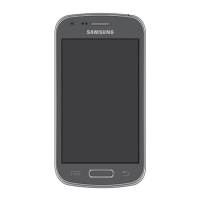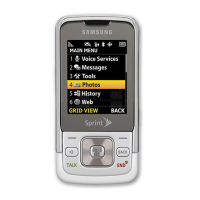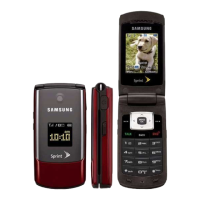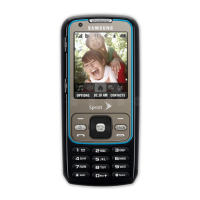Do you have a question about the Samsung SPH-I300 and is the answer not in the manual?
Introduction to the Sprint PCS Phone and its basic functionalities.
Guidance on how to use the user guide effectively.
Identification of physical buttons and features on the phone's front.
Instructions for connecting the phone cradle for charging and synchronization.
Steps for installing and charging the phone's battery.
Procedures for powering the phone on and off.
Steps for initial calibration and setup of the phone's touch screen.
How to adjust the screen's contrast for better visibility.
Explanation of various icons displayed on the phone screen.
Definition and purpose of the handheld computer component.
How to navigate and enter text using the stylus and on-screen keyboard.
Steps to launch and use applications on the handheld computer.
Personalizing settings like time, date, and alert sounds.
Common issues and solutions for the handheld computer.
Procedures for performing soft and hard resets on the device.
Checking if the phone is already activated by the service provider.
Steps to unlock the phone using a lock code.
Instructions for setting up the voicemail box and greeting.
Information on obtaining support via website and customer care.
Using the on-screen keyboard for text input with the stylus.
How to use the Graffiti handwriting recognition system for text input.
Transferring data from a desktop computer to the handheld.
Explanation of roaming indicators and call quality on different networks.
Configuring the phone's service mode for roaming preferences.
Enabling alerts for roaming charges and managing calls.
Methods for initiating phone calls using the dialer and other features.
How to answer incoming calls and manage call state.
Information on viewing and managing missed calls.
How to adjust the phone's ringer volume and vibration settings.
Features available during an active call, such as record and mute.
Setting up and using voice commands to make calls.
Configuring and using speed dial numbers for quick dialing.
Customizing various phone settings like buttons, sounds, and display.
Activating and using voice commands for phone operations.
Features for displaying caller information and blocking your number.
Handling incoming calls while already on a call.
Instructions for conducting calls with three participants.
Activating and deactivating call forwarding to another number.
Understanding how to navigate through application menus and commands.
Overview of available menu commands within applications.
Performing text searches within applications like memos and messages.
Organizing records in applications like Address Book and Memo Pad.
Marking and hiding records for privacy.
Adding notes to records within most applications.
Selecting different font styles for application text.
Displaying application name and version number in the About box.
Transferring data between devices using the infrared port.
Adjusting the ringer volume for incoming calls and alerts.
Modifying earpiece volume during a phone call.
Instructions for turning on and using the speakerphone feature.
How to mute the microphone during a call for privacy.
Alerts and indicators for new messages like voicemail and web alerts.
Sending and receiving text messages via the Sprint PCS website.
Accessing and viewing new text or page messages.
Organizing the message list by date, sender, or subject.
Manually deleting individual or all messages.
Creating filters to organize incoming messages into specific folders.
Accessing font, setup, sounds, and about options for messaging.
Adding new contacts with names, addresses, and phone numbers.
Configuring entry details like list display, category, and special ringer.
Setting up and using speed dial for quick contact access.
Recording and using voice commands to dial contacts.
Initiating calls directly from stored contact entries.
Modifying and reviewing existing contact information.
Transferring contact information to other devices via infrared.
Creating timed and untimed events, including recurring ones.
Setting alarms to remind about scheduled events.
Switching between Day, Week, Month, and Agenda views.
Configuring font, preferences, display, and security for the Date Book.
Configuring the phone to synchronize with desktop email applications.
Composing, reading, and responding to email messages.
Sending emails from the phone, stored in the Outbox until HotSync.
Defining and attaching an automatic signature to outgoing emails.
Limiting message length to save download time and storage.
Permanently removing deleted messages from the device.
Configuring synchronization settings for email items.
Controlling email synchronization based on defined criteria.
Creating rules to filter emails based on To, From, and Subject fields.
Recording daily expenses with type, amount, and category.
Modifying existing expense entries, including the date.
Exporting expense data to Excel for report generation.
Writing and saving notes to the phone's memo pad.
Accessing and modifying existing memos.
Options for managing memos, including record and options menus.
Adding tasks and reminders to the To Do list.
Assigning priority levels to tasks for better organization.
Marking tasks as completed in the list.
Modifying task priorities and due dates.
Removing tasks from the To Do list.
Configuring the display of completed and upcoming tasks.
Accessing record and options menus for To Do List management.
Launching the built-in calculator application.
Explanation of the functions of various calculator buttons.
Reviewing the history of recent calculations performed.
Setting a password to lock the phone and protect private records.
Procedures for modifying or removing the phone's password.
Steps to reset the password if it is forgotten.
Managing the visibility of private entries in applications.
Configuring the phone to lock automatically after a period of inactivity.
Setting call restrictions, allowing only specific call types.
Restoring phone preferences to default factory settings.
Steps to open and start using the web browser.
Using browser icons and tips for navigating web content.
Methods for establishing an internet connection via URL or bookmark.
Saving and opening favorite websites for quick access.
Receiving and viewing real-time information alerts.
Overview of browser menu commands like Go, Back, and Preferences.
Introduction to retrieving information via query and response from the internet.
Comparing web clipping with traditional web browsing on mobile devices.
How web clipping applications function similarly to standard phone apps.
Displaying and categorizing installed applications on the organizer.
Procedures for installing new applications onto the phone.
Removing unused applications to free up memory.
Setting up user profiles for first-time HotSync operations.
Configuring HotSync manager settings for automatic or manual synchronization.
Defining how records are handled for each application during HotSync.
Importing data from external files into phone applications.
Performing HotSync operations using the infrared port.
Configuring HotSync Manager for infrared communication via COM port.
Description of available accessories like batteries, chargers, and hands-free kits.
Information on purchasing accessories through centers, hotline, or website.
Tips for optimizing call quality and understanding phone operation.
Guidelines for safe phone usage, especially while driving.
Proper handling and charging procedures to maximize battery life.
Important notices regarding RF interference, modifications, and FCC compliance.
Legal terms and conditions governing the use of Sprint PCS services.
Samsung's ownership and protection of intellectual property related to the phone.
Details on product warranty, disclaimers, and limitations.
| Model | SPH-I300 |
|---|---|
| Network Technology | CDMA |
| Announced | 2001 |
| Status | Discontinued |
| Dimensions | 119 x 54 x 23 mm (4.69 x 2.13 x 0.91 in) |
| Weight | 159 g (5.61 oz) |
| SIM | Mini-SIM |
| Display Type | Monochrome graphic |
| Display Size | 5 lines |
| Display Resolution | 128 x 64 pixels |
| Phonebook | 200 |
| Loudspeaker | No |
| 3.5mm jack | No |
| Messaging | SMS |
| Games | Yes |
| Java | No |
| Battery type | Li-Ion 1000 mAh battery |
| Stand-by | Up to 160 h |
| Talk time | Up to 3 h |
| Operating System | Palm OS 3.5 |
| Camera | No |
| Network | CDMA 800 / 1900 MHz |
| Alert types | Vibration |
| Languages | English |
| Internal memory | No |
| Storage | No |
| RAM | No |











